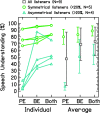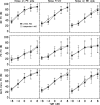Head Shadow, Summation, and Squelch in Bilateral Cochlear-Implant Users With Linked Automatic Gain Controls
- PMID: 34057387
- PMCID: PMC8182628
- DOI: 10.1177/23312165211018147
Head Shadow, Summation, and Squelch in Bilateral Cochlear-Implant Users With Linked Automatic Gain Controls
Abstract
Speech understanding in noise is poorer in bilateral cochlear-implant (BICI) users compared to normal-hearing counterparts. Independent automatic gain controls (AGCs) may contribute to this because adjusting processor gain independently can reduce interaural level differences that BICI listeners rely on for bilateral benefits. Bilaterally linked AGCs may improve bilateral benefits by increasing the magnitude of interaural level differences. The effects of linked AGCs on bilateral benefits (summation, head shadow, and squelch) were measured in nine BICI users. Speech understanding for a target talker at 0° masked by a single talker at 0°, 90°, or -90° azimuth was assessed under headphones with sentences at five target-to-masker ratios. Research processors were used to manipulate AGC type (independent or linked) and test ear (left, right, or both). Sentence recall was measured in quiet to quantify individual interaural asymmetry in functional performance. The results showed that AGC type did not significantly change performance or bilateral benefits. Interaural functional asymmetries, however, interacted with ear such that greater summation and squelch benefit occurred when there was larger functional asymmetry, and interacted with interferer location such that smaller head shadow benefit occurred when there was larger functional asymmetry. The larger benefits for those with larger asymmetry were driven by improvements from adding a better-performing ear, rather than a true binaural-hearing benefit. In summary, linked AGCs did not significantly change bilateral benefits in cases of speech-on-speech masking with a single-talker masker, but there was also no strong detriment across a range of target-to-masker ratios, within a small and diverse BICI listener population.
Keywords: bilateral cochlear implants; binaural technology; spatial release from masking.
Conflict of interest statement
Figures





References
-
- Bates D., Mächler M., Bolker B. M., Walker S. C. (2015). Fitting linear mixed-effects models using lme4. Journal of Statistical Software, 67(1), 1–48. 10.18637/jss.v067.i01 - DOI
Publication types
MeSH terms
Grants and funding
LinkOut - more resources
Full Text Sources
Other Literature Sources
Medical

